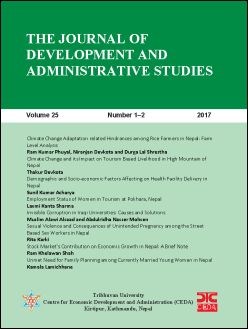Demographic and Socio-economic Factors Affecting on Health Facility Delivery in Nepal
DOI:
https://doi.org/10.3126/jodas.v25i1-2.23436Keywords:
Maternal mortality, delivery practice, skilled birth attendanceAbstract
In Nepal, health facility delivery has improved since the 1990s, but child health delivery facility is still low. In 2001 about 9 percent of the births was delivered at a health facility (MoH, New ERA, and ORC Macro, 2002) which increased to 35 percent in 2011 (MOHP, New ERA, and ICF International Inc, 2012) and further increased to 57 percent in 2016 (MoH, New ERA and ICF, various 2017). This is a rapid increase in health facility delivery since 1996 but still nearly one-half of delivery take place at home. Research in developing countries shows that demographic, social and economic factors influence the utilization of health facility for delivery of births. This paper examines the likelihood of health facility delivery in relation to women’s demographic, social and economic status in Nepal. The 2011 Nepal Demographic and Health Survey (NDHS) data set has been utilized by applying bivariate logistics regression analysis technique to examine the effects of these variables in health facility delivery in Nepal. The analysis findings show large variations and gaps on delivery care based on demographic, social and economic status of women. Against this finding, the study concludes that there is a need for the implementation of appropriate policy and program measures by the government and other agencies to address the existing variations and gaps in utilization of health facility for delivery of births among different sub-groups of women in Nepal. Further research studies focusing on the existing barriers in health facility delivery need to be conducted in Nepal especially among women who are disadvantaged and marginalized.
Downloads
Downloads
Published
How to Cite
Issue
Section
License
The copyright of the accepted articles is reserved by the Centre for Economic Development and Administration (CEDA), Tribhuvan University (TU). No part of the article published in this journal should be reproduced except provided by the law currently in force without the written consent of the centre.




